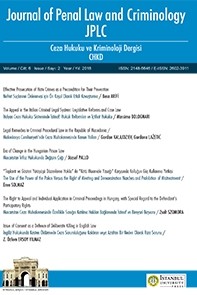European Judicial Cooperation and Protection of Gender-Based Violence Victims, Fact or Fiction?
European Judicial Cooperation and Protection of Gender-Based Violence Victims, Fact or Fiction?
___
- Avilés Palacios L, ‘La perspectiva de género como técnica jurídica e instrumento necesario para una justicia igualitaria’, in AAVV, Análisis de la Justicia desde la perspectiva de género (Tirant Lo Blanch 2018) 279318.
- Barona Vilar S, ‘Justicia penal desde la globalización y la postmodernidad hasta la neomodernidad’ (2018) 27 Rev. Boliv. de Derecho 20-53. - Proceso penal desde la historia. Desde su origen hasta la sociedad global del miedo (Tirant Lo Blanch, Valencia, 2017).
- Bergalli R and Bodelón González E, ‘La cuestión de las mujeres y el derecho penal simbólico’ (1992) 9 Anuario de Filosofía del Derecho 43-74.
- Calvo D, What is the Problem of Gender? Mainstreaming Gender in Migration and Development Policies in the European Union, University of Gothenburg, 2013, 20-28.
- Carrasquero Cepeda M, ‘Orden Europea de Protección: Un paso adelante en la protección de las víctimas’ (2014) 2 CEJJ 91-114.
- De Luis García E, ‘El Derecho a una investigación efectiva en la jurisprudencia del TEDH’ (2019) 27 Rev. Boliv. de Derecho 494-515.
- Etxebarría Estankona K, ‘El reglamento (UE) 606/2013 relativo al reconocimiento mutuo de medidas de protección en materia civil. Algunas cuestiones sobre su aplicación’, in Katixa Etxebarría Estankona, Ixusco Ordeñana Gezuraga and Goixeder Otauza Zabala (dirs.), Justicia con ojos de mujer. Cuestiones procesales controvertidas (Tirant Lo Blanch 2018) 385-408.
- Fantuzzo J W, Mohr W and Noone M J K, ‘Making the Invisible Victims of Violence Against Women Visible Through University/Community Partnerships’ in Robert A. Geffner, Peter G. Jaffe and Marlies Sudermann (eds.), Children exposed to domestic violence. Current Issues in Research, Intervention, Prevention and Policy Development (HMTP, 2000).
- García Rodríguez M J, ‘Aplicación de la Orden Europea de Protección a las víctimas en el sistema de justicia penal español a través de la ley de reconocimiento mutuo de resoluciones penales en la Unión Europea’ (2015) 37 Revista General de Derecho Procesal.
- Garrido Carrillo F J and Faggiani V, ‘La armonización de los derechos procesales en la UE’ (2013) 16 Revista General de Derecho Constitucional 2-7.
- ISSN: 2148-6646
- Yayın Aralığı: 2
- Başlangıç: 2014
- Yayıncı: Adem Sözüer/ Rahime ERBAŞ
Ayşe Dolunay SARICA, Umut Haydar COŞKUN
European Judicial Cooperation and Protection of Gender-Based Violence Victims, Fact or Fiction?
Aksayan Adalet: Amerikan İç Savaşı Sonrası Gerçekleştirilen Henry Wirz Yargılaması
Alman Yeni Darknet Ceza Kanunu Tasarısı: Bireysel Hakları Kısıtlayarak Karartma
Bir Suçu Ağır Yapan Nedir? Warr’un Suç Ağırlığı Modelinin bir Testi
The Criminal Liability of the Compliance Officer: An Approach Through Several Hard Cases
